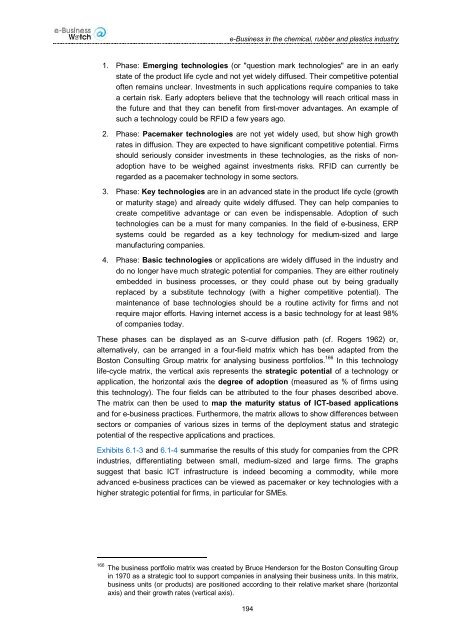Downloads - empirica
Downloads - empirica
Downloads - empirica
You also want an ePaper? Increase the reach of your titles
YUMPU automatically turns print PDFs into web optimized ePapers that Google loves.
e-Business in the chemical, rubber and plastics industry1. Phase: Emerging technologies (or "question mark technologies" are in an earlystate of the product life cycle and not yet widely diffused. Their competitive potentialoften remains unclear. Investments in such applications require companies to takea certain risk. Early adopters believe that the technology will reach critical mass inthe future and that they can benefit from first-mover advantages. An example ofsuch a technology could be RFID a few years ago.2. Phase: Pacemaker technologies are not yet widely used, but show high growthrates in diffusion. They are expected to have significant competitive potential. Firmsshould seriously consider investments in these technologies, as the risks of nonadoptionhave to be weighed against investments risks. RFID can currently beregarded as a pacemaker technology in some sectors.3. Phase: Key technologies are in an advanced state in the product life cycle (growthor maturity stage) and already quite widely diffused. They can help companies tocreate competitive advantage or can even be indispensable. Adoption of suchtechnologies can be a must for many companies. In the field of e-business, ERPsystems could be regarded as a key technology for medium-sized and largemanufacturing companies.4. Phase: Basic technologies or applications are widely diffused in the industry anddo no longer have much strategic potential for companies. They are either routinelyembedded in business processes, or they could phase out by being graduallyreplaced by a substitute technology (with a higher competitive potential). Themaintenance of base technologies should be a routine activity for firms and notrequire major efforts. Having internet access is a basic technology for at least 98%of companies today.These phases can be displayed as an S-curve diffusion path (cf. Rogers 1962) or,alternatively, can be arranged in a four-field matrix which has been adapted from theBoston Consulting Group matrix for analysing business portfolios. 166 In this technologylife-cycle matrix, the vertical axis represents the strategic potential of a technology orapplication, the horizontal axis the degree of adoption (measured as % of firms usingthis technology). The four fields can be attributed to the four phases described above.The matrix can then be used to map the maturity status of ICT-based applicationsand for e-business practices. Furthermore, the matrix allows to show differences betweensectors or companies of various sizes in terms of the deployment status and strategicpotential of the respective applications and practices.Exhibits 6.1-3 and 6.1-4 summarise the results of this study for companies from the CPRindustries, differentiating between small, medium-sized and large firms. The graphssuggest that basic ICT infrastructure is indeed becoming a commodity, while moreadvanced e-business practices can be viewed as pacemaker or key technologies with ahigher strategic potential for firms, in particular for SMEs.166 The business portfolio matrix was created by Bruce Henderson for the Boston Consulting Groupin 1970 as a strategic tool to support companies in analysing their business units. In this matrix,business units (or products) are positioned according to their relative market share (horizontalaxis) and their growth rates (vertical axis).194
















